Top 10 activities to do in Ouarzazate
Ouarzazate is a city located in the south of Morocco, in the Drâa-Tafilalet region. It is often referred to as “the gateway to the desert” due to its proximity to the Sahara. The history of Ouarzazate dates back several centuries, and the region has been inhabited by various civilizations over time.
The city itself was founded in the 18th century by the Alaouites, a Moroccan dynasty. It was built at a strategic trading crossroads between the north and south of the country. Thanks to its geographic location, Ouarzazate played a key role in the history of trans-Saharan trade, serving as a departure point for caravans heading into the desert.
During the 20th century, Ouarzazate experienced significant development due to its tourism potential and natural resources. The city is famous for its stunning desert landscapes, traditional kasbahs, and film studios. In fact, Ouarzazate has become a popular filming location for many international movies and series, including Lawrence of Arabia, Gladiator, and Game of Thrones.
Today, Ouarzazate continues to thrive as a major tourist destination in Morocco, attracting visitors from around the world who come to explore the Sahara, discover the traditional architecture of the kasbahs, and visit the film studios. The city also remains economically important as a commercial and administrative center for the region.
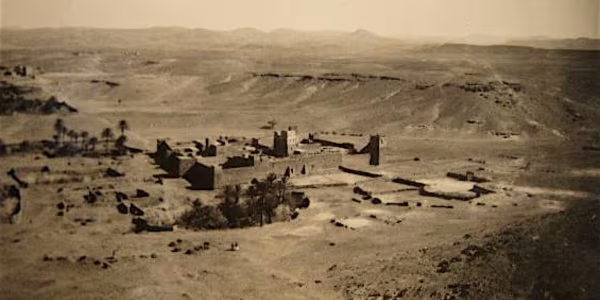
Top 10 activities to do in Ouarzazate
Ouarzazate, Morocco, is a must-visit destination for travelers seeking adventure and cultural discoveries. This city is known for its breathtaking landscapes, surrounded by arid deserts and stunning oases. Its kasbahs, listed as World Heritage sites, offer visitors a fascinating glimpse into traditional Moroccan architecture. Some of these kasbahs have even been converted into tourist accommodations, providing a unique and authentic experience. Ouarzazate is also famous for its film studios, which have hosted the shooting of numerous international movies and series. Whether you want to explore the Dades and Draa valleys, the Todra gorges, or the Merzouga desert, Ouarzazate is the perfect starting point for adventures in southern Morocco.
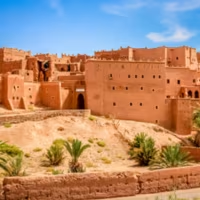
To fully enjoy your trip to Ouarzazate, be sure to rent a car from Thrifty Morocco via their website and pick it up at one of our agencies in Ouarzazate:
Ouarzazate Airport Agency
Ouarzazate City Center Agency
By choosing this option, you will be able to thoroughly explore both nearby and more distant tourist activities right from your arrival, maximizing your sightseeing opportunities during your trip to Ouarzazate.
1- Taourirt Kasbah in Ouarzazate: Berber Treasure, Cinema Landmark, and Historical Heritage
We start our Top 10 guide with the Taourirt Kasbah in Ouarzazate, one of Morocco’s most iconic attractions and a site of great historical importance. Here is an overview of this magnificent kasbah located in the city of Ouarzazate.
The Taourirt Kasbah is an impressive example of traditional Berber architecture. It was built in the 18th century by the powerful Glaoua tribe, which was one of the most influential families in Morocco at the time. The kasbah served as the residence of the tribe’s leader, the Pasha Glaoui, and was also a major political and economic center in southern Morocco.
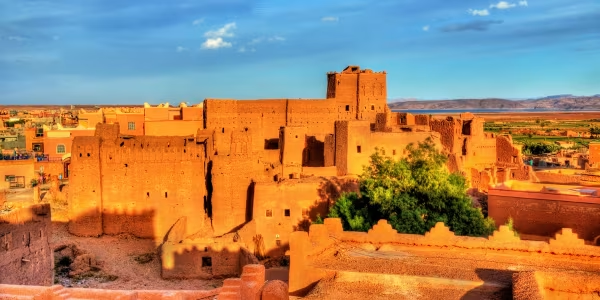
The architecture of the Taourirt Kasbah is a fascinating blend of beauty and functionality. It is built using rammed earth, a traditional construction technique that involves mixing raw earth with straw and lime to form massive walls. The kasbah features multiple towers, narrow passageways, inner courtyards, and richly decorated rooms. Its ochre-colored earthen walls give it a warm and authentic appearance.
The Taourirt Kasbah stands as a living testament to the Berber culture that prevailed in the city for centuries. The intricate decorative patterns, carved details, and interior spaces designed to maximize protection against the elements and possible attacks reflect the ingenuity of local craftsmen.
In addition to its historical significance, the Taourirt Kasbah has also played a major role in the film industry. Many famous movies, such as Lawrence of Arabia and Gladiator, were filmed at this kasbah, contributing to its international fame. This has made it a highly popular tourist destination, attracting visitors from around the world eager to discover both its cultural heritage and cinematic legacy.
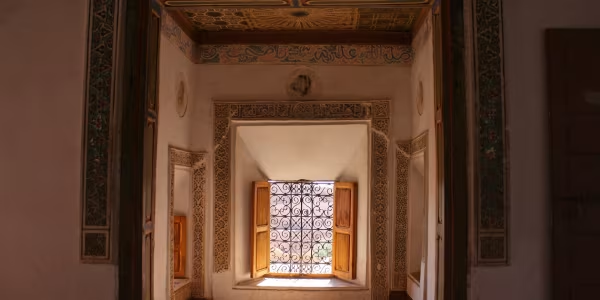
Today, the Taourirt Kasbah is open to visitors who wish to explore its fascinating history, mysterious corridors, and magnificent interiors. A visit to the kasbah offers insight into traditional Moroccan life and architecture, as well as an opportunity to immerse yourself in the unique atmosphere of this historic site.
2- The Cinema Museum in Ouarzazate: A Captivating Journey Through Moroccan Film History
The Cinema Museum in Ouarzazate, also known as the Ouarzazate Cinema Museum, is an important cultural attraction located in the city. This museum is a must-visit for film enthusiasts and curious visitors eager to discover the rich and diverse history of Morocco’s film industry.
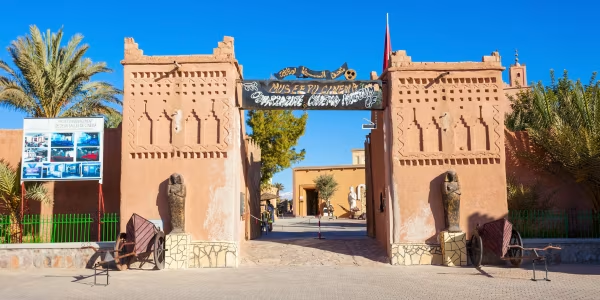
The museum was inaugurated in 1987 in a renovated old kasbah, demonstrating a commitment to preserving and showcasing Ouarzazate’s cinematic heritage. The city is often nicknamed the "Hollywood of the Desert" due to the large number of film productions shot there.
The Cinema Museum offers a variety of exhibitions and collections that trace the history of cinema in Morocco. You will find film posters, photographs from film sets, costumes and props used in famous movies, as well as information about directors and actors who have worked in the region. These exhibits provide a fascinating insight into the impact of cinema on local culture and economy.
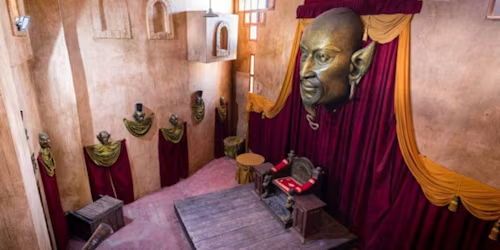
The museum allows visitors to understand the essential role Ouarzazate has played in the international film industry. Many renowned films, such as Lawrence of Arabia, Gladiator, and Game of Thrones, were shot with breathtaking views of the surrounding areas. The museum pays tribute to these productions and to the entire film industry that has thrived in this city.
Beyond its museum function, the Cinema Museum offers educational programs and workshops for visitors of all ages. These initiatives aim to raise public awareness about the art of cinema, filmmaking, and the importance of local cinematic heritage.
3- Tifoultoute Kasbah: A Hidden Treasure of Berber Architecture in Morocco
The Tifoultoute Kasbah is another architectural and historical marvel located near the city of Ouarzazate, in the southern region of Morocco. Although less known than the Taourirt Kasbah, it has an equally fascinating history and beauty.
The Tifoultoute Kasbah was built in the 18th century and served as the residence of the leader of the Glaoua tribe—the same tribe that built the Taourirt Kasbah. This kasbah also played a strategic role as a checkpoint on the caravan route connecting Sub-Saharan Africa to northern Morocco.
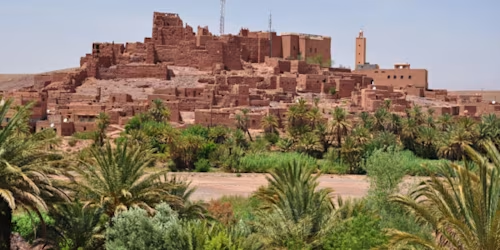
Like the Taourirt Kasbah, the Tifoultoute Kasbah is an impressive example of traditional Berber architecture. It is built using rammed earth, with raw earthen walls reinforced by wooden beams and intricate carved patterns on the façade. The kasbah’s buildings are arranged around a central courtyard, typical of kasbah architecture, and offer breathtaking views of the Ounila Valley.
The location of the Tifoultoute Kasbah is spectacular. It is perched on a hill overlooking the Ounila Valley, offering panoramic views of the Atlas Mountains and the surrounding desert. Sunsets from the kasbah are especially impressive. Although less visited than the Taourirt Kasbah, the Tifoultoute Kasbah still attracts travelers seeking authenticity and natural beauty. Visitors can explore narrow alleys, historic rooms, and terraces with breathtaking panoramas. It is also possible to experience local culture by enjoying a mint tea at one of the nearby small shops.
4- Aït Ben Haddou: The Moroccan Kasbah That Conquered Hollywood
The Aït Ben Haddou Kasbah, or Ait Benhaddou, is one of the most iconic attractions near Ouarzazate, Morocco. This kasbah is an architectural masterpiece built with rammed earth and is a UNESCO World Heritage site that embodies the history, culture, and beauty of southern Morocco.
Aït Ben Haddou dates back several centuries, with origins around the 11th century. It was built as a ksar, a fortified village, by the Berber tribe of Aït Aïssa. Over the years, it became a trading crossroads and an important stop for caravan trade routes connecting the Sahara to Marrakech.
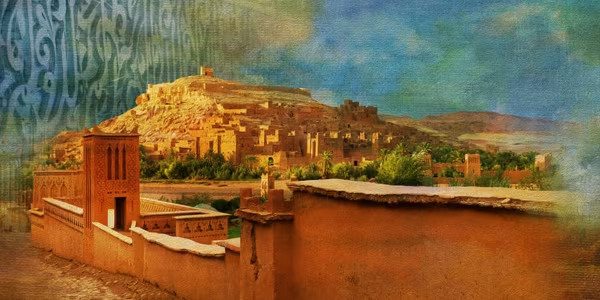
The architecture of the Aït Ben Haddou Kasbah is an exceptional example of rammed earth construction, a traditional technique that uses raw earth mixed with straw and lime to form solid walls. The kasbah is built on multiple levels, featuring narrow alleys, vaulted passageways, and earthen houses stacked upon one another. Its structure is adapted to the region’s extreme climate conditions, providing insulation against the summer heat and winter cold. Today, the Aït Ben Haddou Kasbah is a symbol of Berber culture and Moroccan history. Visitors can explore its winding alleys, traditional houses, and watchtowers. It is also known for its engravings and artistic motifs that tell the story and customs of the town’s inhabitants.
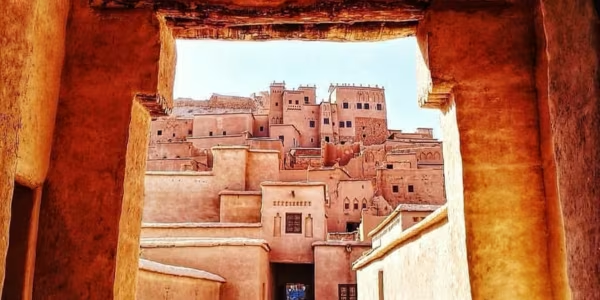
The Aït Ben Haddou Kasbah is famous for serving as the setting for many international films and productions. Movies such as Gladiator, Lawrence of Arabia, Joyeux Noël d’Harry (Harry’s Christmas), and the TV series Game of Thrones were all filmed here. This has contributed to its worldwide fame and made it a pilgrimage site for film enthusiasts. The Aït Ben Haddou Kasbah is one of Morocco’s most popular tourist attractions. Visitors flock to discover its timeless charm, authentic atmosphere, and rich historical past. The kasbah’s alleys are lined with local craft shops where visitors can buy handmade products, Berber rugs, and other souvenirs.
5- The Old Synagogue of the Mellah in Ouarzazate: A Journey Through Time Between Jewish and Amazigh Cultures
Built over four centuries ago, the old synagogue stands majestically in the heart of the Mellah (the Jewish quarter). It is distinguished by Hebrew symbols adorning its exterior, and its modest entrance door hints at a narrow interior space. However, once you step inside, you discover a place that is both vast in scale and rich in treasures and mysteries.
This historic structure extends over several levels and includes a study hall as well as several rooms. After it ceased to function as a place of worship, these spaces were transformed into exhibition rooms, each telling a facet of the daily life of a Jewish Amazigh family. The old synagogue is now beautifully preserved thanks to the considerable efforts of the family managing it, and it is open to anyone wishing to explore this cultural and religious symbol filled with historical testimonies.

This place offers an immersive experience into history and culture, housing a multitude of authentic objects related to Jewish worship and daily life, preserved in their original environment. Much more than a simple museum, the old synagogue provides a true journey through time, allowing visitors to discover the fascinating history that has linked the Jewish and Amazigh communities of the region for centuries. It stands as a vivid testimony to this unique cultural and religious coexistence.
6- Atlas Studios in Ouarzazate: Behind the Scenes of Cinematic Magic in Morocco
Atlas Studios is one of the largest and most famous film production complexes in Morocco, located near the city of Ouarzazate in the south of the country. These studios have become a major hub for the film industry, not only in Morocco but also internationally.
Here is an overview of the Atlas Studios in Ouarzazate. Founded in 1983 to meet the growing demand for exotic and diverse filming locations, the Ouarzazate region—with its spectacular desert landscapes, the Atlas Mountains, and historic kasbahs—proved to be an ideal choice for film productions. Since then, the studios have hosted numerous internationally renowned films and TV series.
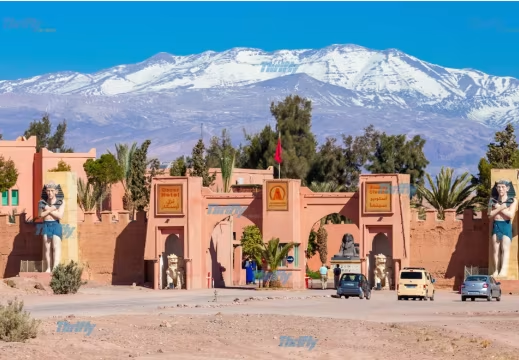
Atlas Studios cover a vast area and are equipped with sets, filming stages, support structures, and everything needed for film production. The sets include replicas of historic cities, medieval castles, traditional Moroccan villages, and much more. The studios also offer post-production services, special effects, and equipment rental.
Atlas Studios have been the filming location for many successful movies, including Lawrence of Arabia (1962), Gladiator (2000), The English Patient (1996), Kingdom of Heaven (2005), and the TV series Game of Thrones. These productions have contributed to the worldwide fame of the studios and have showcased Morocco’s stunning landscapes.
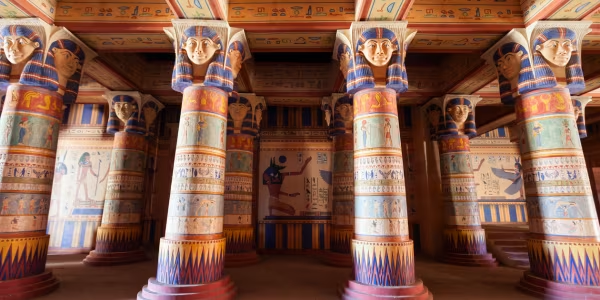
In addition to serving as a filming location, Atlas Studios also welcome curious tourists eager to discover behind the scenes. Visitors can explore famous film sets, tour the shooting stages, see costumes and props, and learn more about the film industry in Morocco. It’s a unique experience for cinema lovers and travelers alike.
7- Tizi n’Tichka: The Spectacular Route Through the Atlas Mountains in Morocco
Tizi n’Tichka is a spectacular mountain pass located near the city of Ouarzazate, in the Souss-Massa-Drâa region of Morocco. It is one of the highest mountain passes in North Africa and an important road connecting northern Morocco to the Sahara region.
Here is an overview of Tizi n’Tichka and its significance. Also spelled Tichka or Tizi n’Tichka, it sits at an altitude of 2,260 meters (7,415 feet) above sea level. This makes it the highest point of National Route N9, which crosses the Atlas Mountains from Marrakech to Ouarzazate.
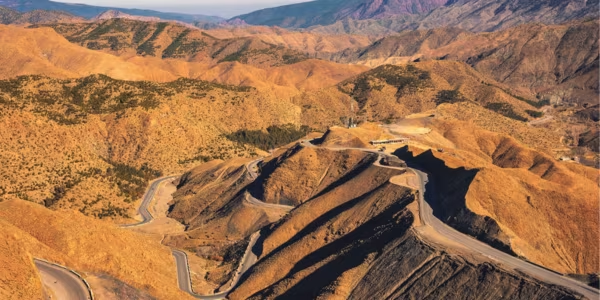
The pass offers breathtaking panoramas of the Atlas Mountains. Tourists can admire lush valleys, rocky ridges, deep gorges, and snow-capped peaks in winter. This natural scenery of unparalleled beauty makes it a major tourist attraction. The road through Tizi n’Tichka is a historic route that has been used for centuries to connect northern Morocco with the Sahara regions. Before the modern era, this route was traveled by trade caravans, travelers, and nomadic peoples who relied on the pass as an essential crossing point.
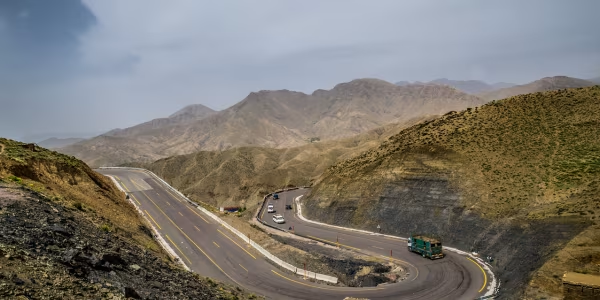
Many visitors make stops along the Tizi n’Tichka road to admire the landscapes, buy local handicrafts, and visit traditional Berber villages. Some stops also offer hiking opportunities to further explore the Moroccan Atlas Mountains. The Tizi n’Tichka pass can experience extreme weather conditions in winter, with snow and freezing temperatures. Therefore, it is important to take precautions when traveling during the winter season.
8- The Draa River: Life and Natural Beauty in the Heart of Southern Morocco
The Draa River is one of the longest waterways in Morocco, originating in the Atlas Mountains and flowing for about 1,100 kilometers before emptying into the Atlantic Ocean near the city of Tan-Tan. Although it does not pass directly through Ouarzazate, the Draa River plays an essential role in the region and deserves mention for its impact on local life and the environment.
The Draa River is a seasonal river, meaning it only contains water during certain times of the year, particularly during the rainy seasons. During the dry season, the riverbed can be completely dry in some parts of its course.

The Draa River is of vital importance to the region in terms of irrigation and agriculture. Its underground waters feed the lush palm groves that are characteristic of the Draa region, especially in the Draa Valley, located south of Ouarzazate. These palm groves produce dates, vegetables, and other crops that are essential for the local economy and the livelihood of its inhabitants.
The surroundings of the Draa River offer spectacular natural landscapes, including deep gorges and green valleys that contrast with the surrounding desert. These areas are often explored by hiking enthusiasts and tourists seeking natural beauty and adventure.
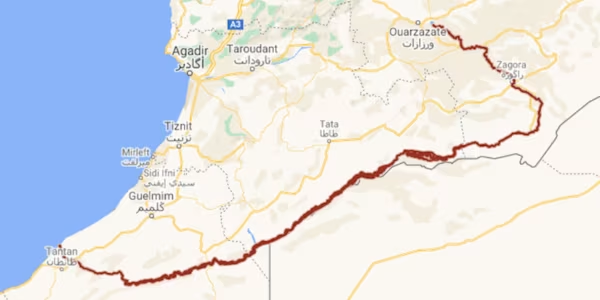
The Draa Valley is also renowned for its Berber culture and heritage. Traditional villages, earthen kasbahs, and historic monuments line the valley, offering visitors a glimpse into the life and history of the region. The Draa Valley attracts many tourists each year, especially those traveling the Kasbah Route—a tourist route that connects Ouarzazate to Zagora through the valley. People can explore the palm groves, Berber villages, ancient kasbahs, and enjoy the peaceful beauty of the area.
9- The Noor Solar Power Plant in Ouarzazate: A Giant Leap Toward Solar Energy in Morocco
The Noor Solar Power Plant is a solar complex located in the Ouarzazate region of Morocco. It is the largest concentrated solar power (CSP) complex in the world. The Noor complex consists of several phases, with the first phase inaugurated in 2016.
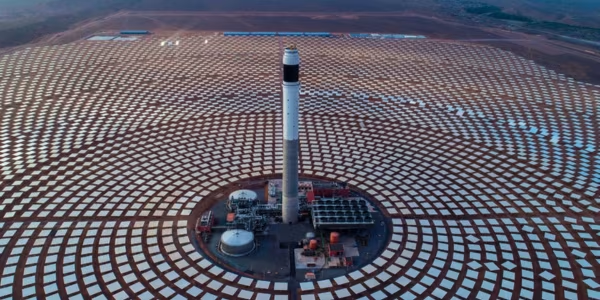
The Noor Solar Power Plant uses different solar technologies, including parabolic mirrors and solar towers, to generate electricity from solar energy. The complex also features an energy storage system that allows it to supply electricity even during the night.
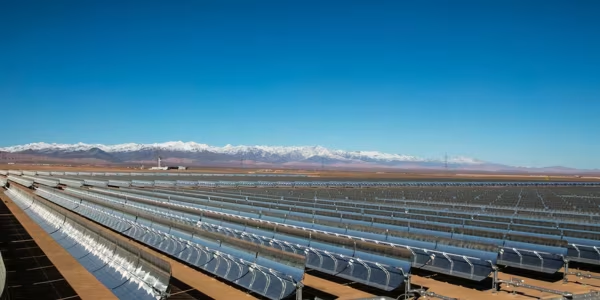
The Noor complex in Ouarzazate helps Morocco reduce its dependence on fossil fuels and increase the share of renewable energy in the country’s energy mix. It also contributes to the fight against climate change by reducing greenhouse gas emissions.
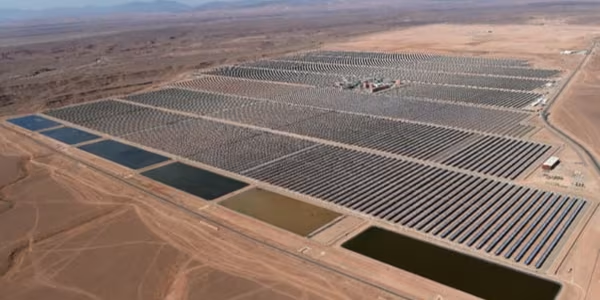
This solar power plant is not only a technological feat but has also become a popular tourist attraction. Visitors can explore the solar facilities and learn more about Morocco’s transition to clean energy.
10- Discovering Merzouga: The Majestic Sand Dunes of the Moroccan Desert near Ouarzazate
Merzouga is a small village located in the Sahara Desert, in the Ouarzazate region in southeastern Morocco. It is famous for its impressive sand dunes, particularly the Erg Chebbi dunes, which are among the tallest sand dunes in the Sahara. Merzouga is a must-visit destination for explorers who want to experience the Moroccan desert.
Here’s an overview of Merzouga. The Erg Chebbi dunes are the main attraction in Merzouga. These sand dunes stretch about 22 kilometers long and reach heights of over 150 meters. Visitors come here to admire the spectacular dunes, go on camel treks, and enjoy unforgettable sunsets.

One of the most popular experiences in Merzouga is the camel trek across the dunes. You can book a one-night or multi-day excursion that takes you deep into the desert to discover nomadic life and spend the night under the stars.

Nothing compares to the experience of spending a night in the desert. Berber camps offer comfortable accommodations in traditional tents, along with meals prepared using local ingredients. Nights in the desert provide breathtaking views of the starry sky.
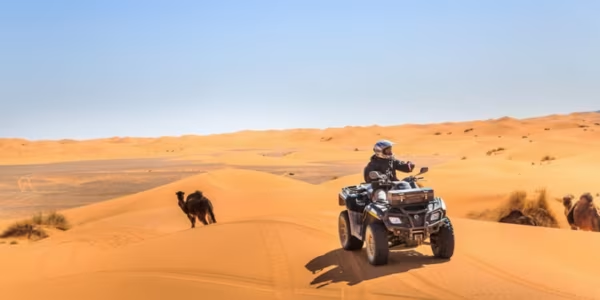
Besides camel rides, Merzouga offers other exciting desert activities, including sandboarding, 4x4 excursions across the dunes, and opportunities to meet the Berber nomads who live in the area.
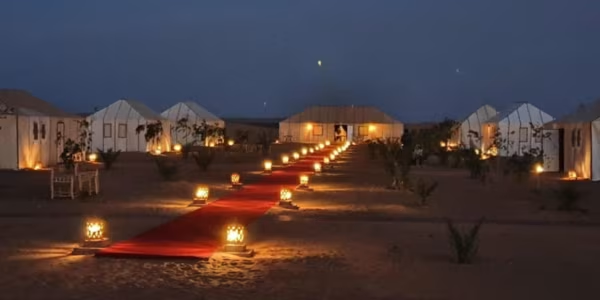
Vous aurez l'occasion d'en apprendre davantage sur la culture berbère du désert. Les habitants de Merzouga sont chaleureux et accueillants, et vous pourrez en apprendre plus sur leurs traditions, leur musique et leur cuisine.
À proximité de Merzouga se trouve le lac Dayet Srji, un lac saisonnier qui attire de nombreuses espèces d'oiseaux, notamment des flamants roses. C'est un endroit intéressant pour les amateurs de nature et d'ornithologie.
Autres lieux à visiter à Ouarzazate :
Casbah de Tamesla
Gorges de Todra
Vallée des roses
Gorges de dadès
Kingdom of heaven
Oasis de Fint
Souks du centre ville de Ouarzazate